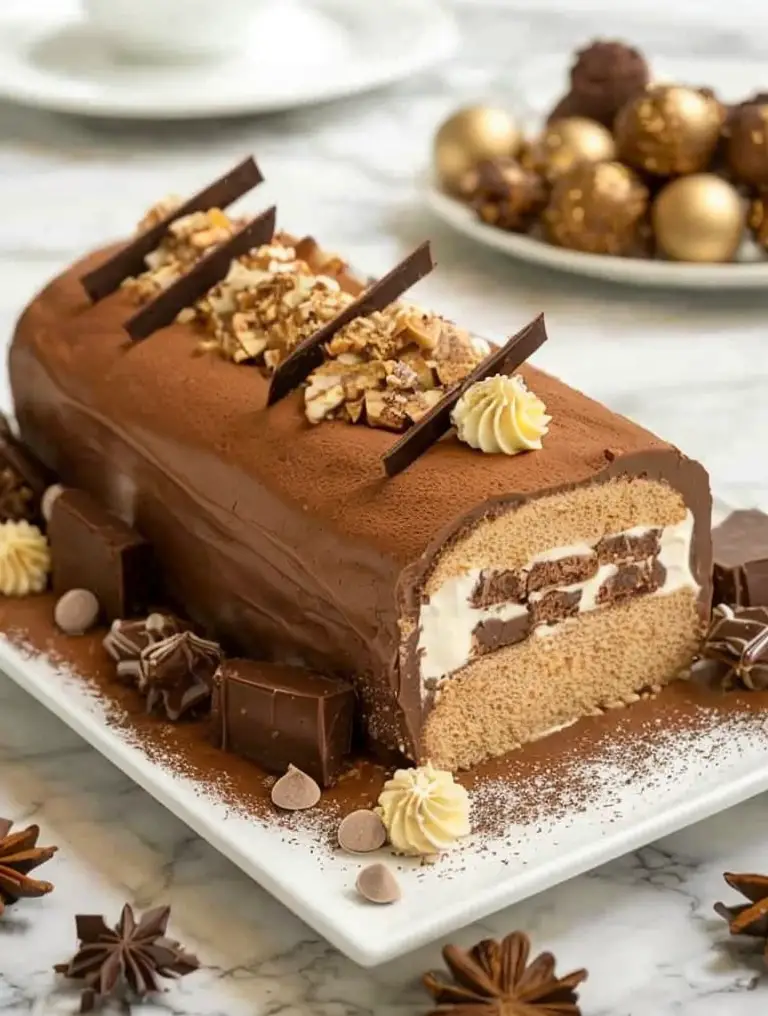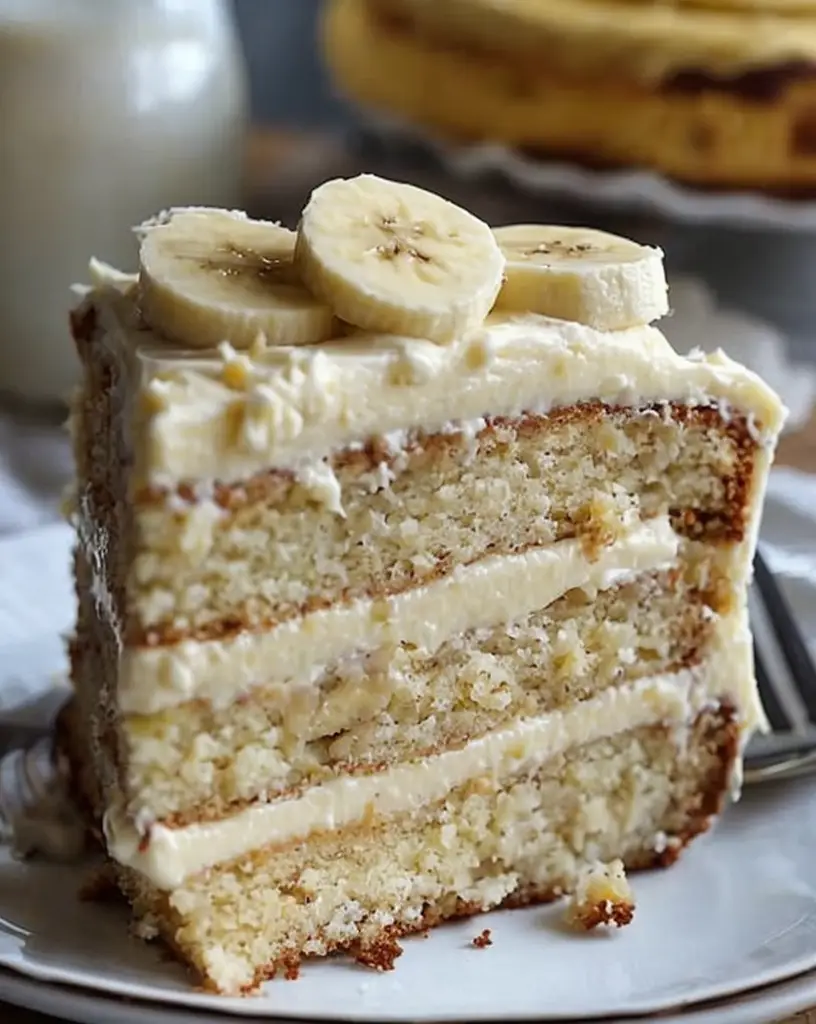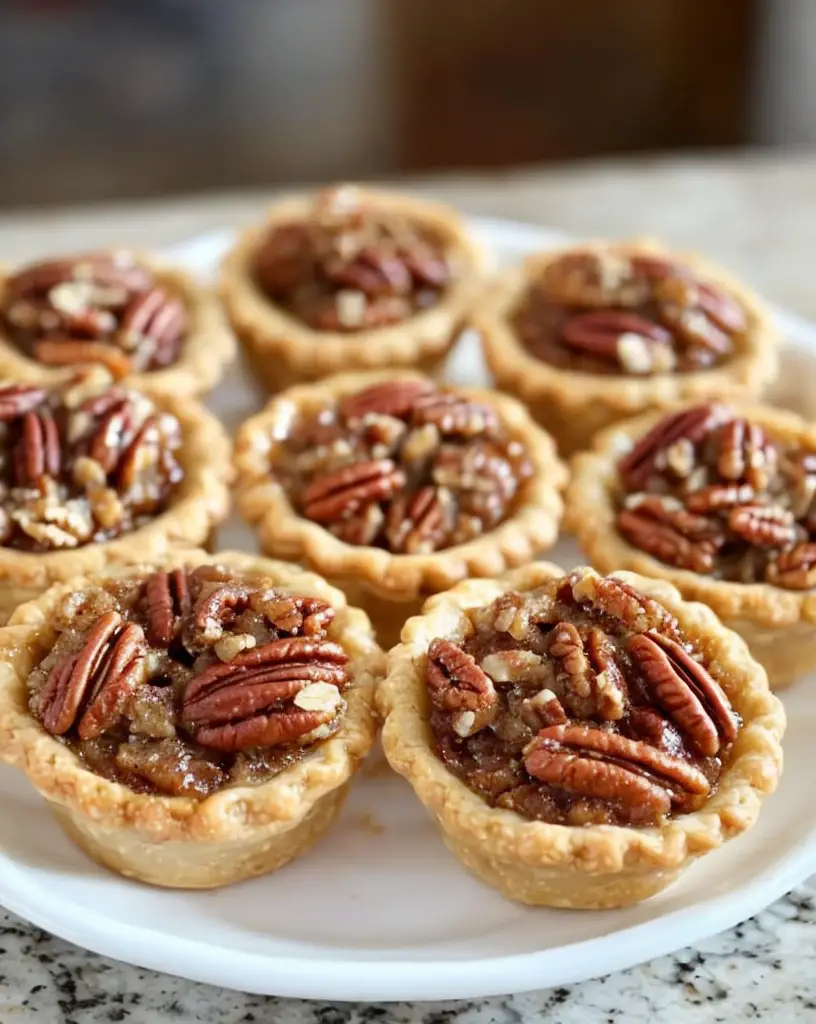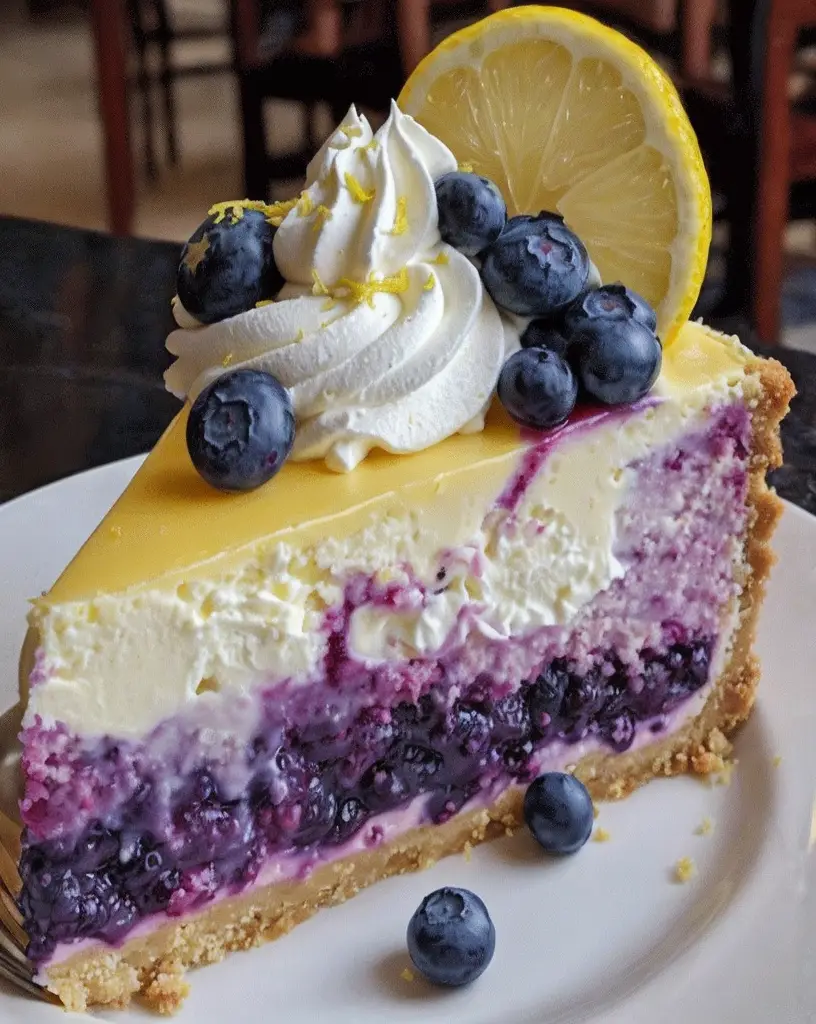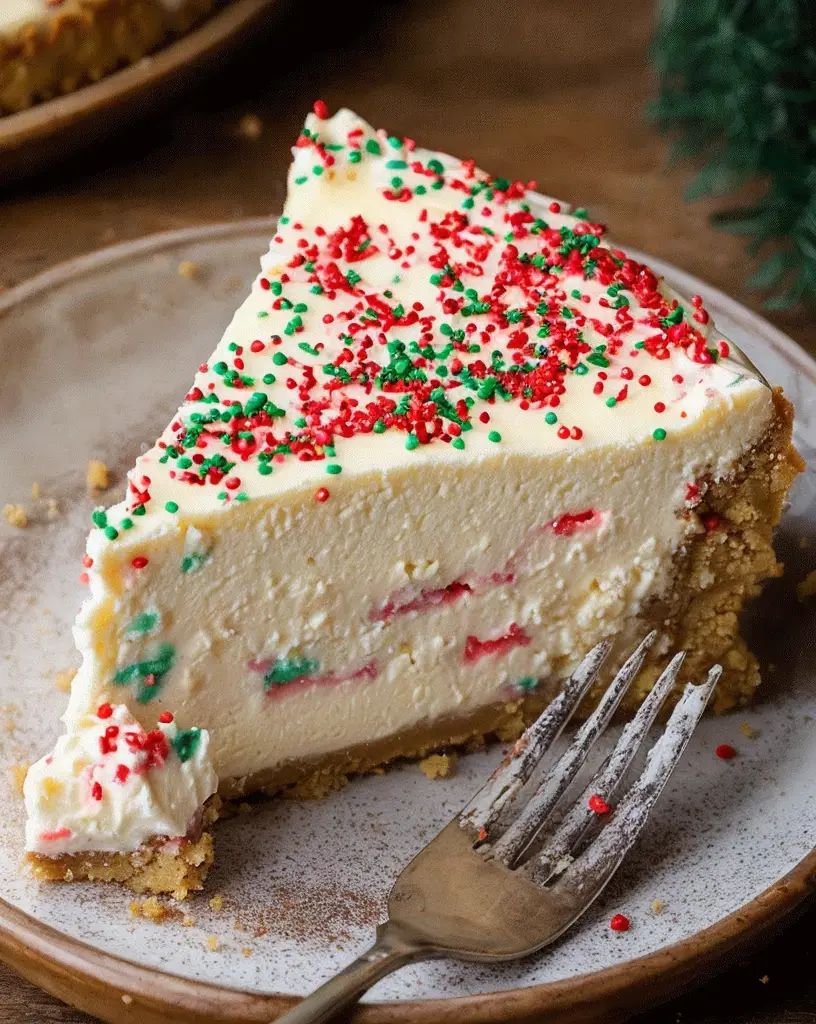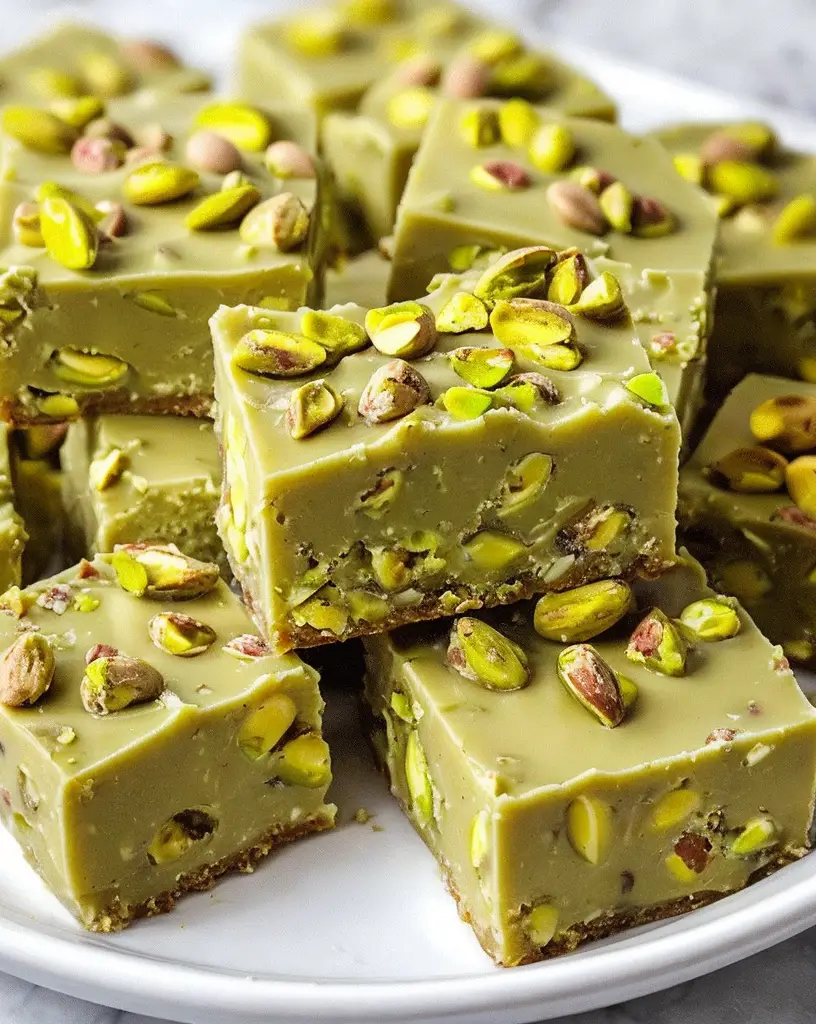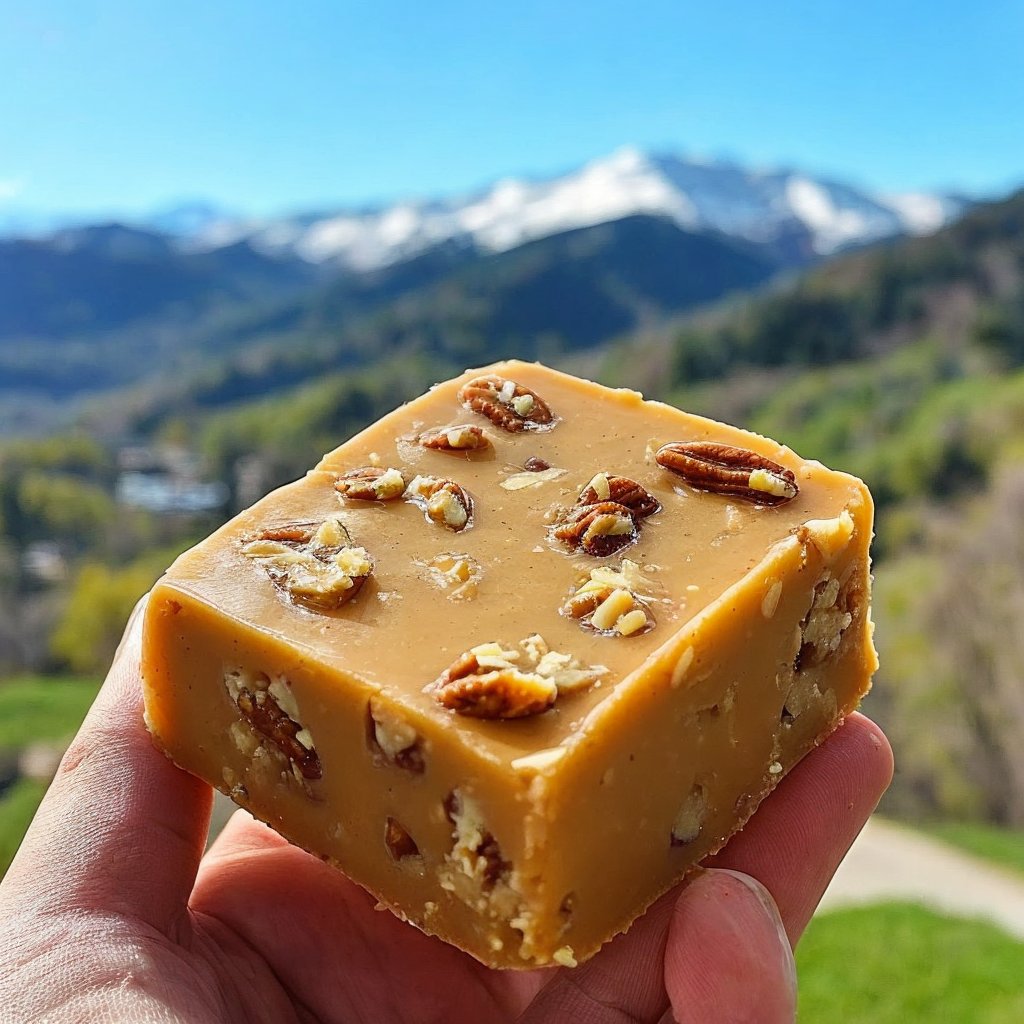Chocolate & Praline Yule Log: A Decadent Holiday Delight
The Chocolate & Praline Yule Log is a festive gourmet dessert that captures the essence of the holiday season. This luxurious dessert combines the rich, velvety taste of chocolate with the irresistible crunch of praline. Crafted into a beautiful roulade reminiscent of a traditional yule log, this dessert is perfect for Christmas celebrations or any wintertime gathering. Whether you’re an experienced baker or a kitchen novice, you’ll find joy in creating this masterpiece.
Quick Recipe Highlights
- Flavor Profile: This yule log offers a harmonious blend of deep chocolate richness and sweet, nutty praline, making each bite a perfect balance of flavors.
- Texture: Enjoy the contrast of a soft, moist chocolate sponge with a creamy filling and the crunchy surprise of praline pieces.
- Aroma: The log fills your home with the inviting scent of cocoa mingled with subtle hints of toasted nuts, evoking cozy winter nights.
- Visual Appeal: The Chocolate & Praline Yule Log is visually stunning with its smooth chocolate glaze and decorative elements like chocolate shavings or gold dust.
- Skill Level Needed: Requires intermediate baking skills, including rolling a sponge cake and preparing a praline filling.
- Special Equipment: Use a jelly roll pan and a reliable mixer to ensure perfect consistency in your sponge and filling.
Recipe Overview
- Difficulty Level: Intermediate, involving multiple steps like sponge preparation, praline making, and rolling, which requires some baking experience.
- Category: Dessert is perfect for festive occasions and impressive dinner party finales.
- Cuisine: This recipe is rooted in European holiday traditions, particularly French patisserie.
- Cost: Moderate; main ingredients include chocolate, cream, and nuts, which are affordable yet luxurious.
- Season: Best enjoyed during winter as a centerpiece for holiday celebrations.
- Occasion: Ideal for Christmas, New Year’s celebrations, or any occasion that demands a show-stopping dessert.
Why You’ll Love This Recipe
The Chocolate & Praline Yule Log is a decadent treat that melts in your mouth, offering a medley of textures and flavors with every forkful. Not only does it satisfy chocolate cravings, but it also captivates with the surprise of praline crunch, making it a hit among dessert enthusiasts.
Preparing this log ahead of time allows you to enjoy the festivities without stress. The components can be made in advance for easy assembly on party day. This convenience also helps the flavors meld beautifully overnight, resulting in a richer taste.
Rich in flavor but crafted to be lighter, it remains a delightful indulgence without excessive guilt. The use of high-quality cocoa and nuts brings nutritional benefits like antioxidants and healthy fats, adding to its appeal.
Not only does it satisfy sweet cravings, but the yule log also serves as a centerpiece on festive tables, drawing viewers to its elegance and adding to the celebratory atmosphere. Its impressive presentation makes it a conversation starter at any gathering.
Despite its fancy appearance, the ingredients are largely accessible and affordable, ensuring that anyone can create this masterpiece without breaking the bank or relying on obscure items.
Historical Background and Cultural Significance
Originating from the European Yule tradition, the yule log began as a substantial wooden log burned on the hearth during Christmas, symbolizing the return of the light. Culinary interpretations started in the late Middle Ages when elaborate desserts became a key part of celebrations.
The yule log cake, or “Bûche de Noël,” evolved over centuries, incorporating local flavors and techniques. In France, it became a staple Christmas dessert, with variations emerging in different regions based on available ingredients and local customs.
Modern yule logs now span cultures globally, each offering unique takes on the classic. Some incorporate tropical flavors in warmer climates, while others integrate traditional spices for a comforting winter experience. Regardless of the variation, the foundational theme of warmth and celebration remains intact.
Regional adaptations continue to proliferate, showcasing culinary creativity worldwide. Each iteration reflects both local tastes and universal holiday joy, making the yule log an enduring and beloved dessert.
Ingredient Deep Dive
**Chocolate**: Chocolate is the star ingredient, with a rich history dating back to ancient civilizations like the Aztecs and Mayans. Its journey from a bitter beverage to a sweetened delicacy mirrors cultural amalgamations that reflect trade and exploration. Opt for high-quality dark chocolate, as it provides antioxidants and richer flavors.
Once purchased, store chocolate in a cool, dark place to maintain its aroma and prevent blooming. If necessary, substitute semisweet chocolate while adjusting sugar levels to maintain balance.
**Praline**: A beloved candy with French roots, praline introduces a nutty sweetness to the dessert. Not only does it enhance flavor, but it also adds a delightful crunch, creating a textural contrast with the creamy filling. Rich with heart-healthy fats and minerals like magnesium, pecans or hazelnuts are preferred choices.
Select fresh nuts, and store them in a sealed container to prolong freshness. In case of allergies, sunflower seeds offer a nut-free alternative to maintain texture.
Common Mistakes to Avoid
- Overbaking the sponge can result in a dry log, making rolling difficult. Monitor closely and remove from the oven as soon as it’s firm to the touch.
- Failing to roll the cake while warm can lead to cracks. Use a damp towel to assist in rolling and avoid tears.
- Skipping a cool fill time prevents flavors from melding. Complete filling preparation early and chill as needed before spreading.
- Omitting praline from the cream may lead to a flavorless filling. Incorporate nuts for texture and taste enhancement.
- Not sifting cocoa powder leads to a lumpy batter. Sift all dry ingredients before mixing to ensure a smooth texture.
- Rolling too tightly may squeeze out filling, so maintain gentle yet firm pressure to achieve a perfect roll.
- Forgetting to temper chocolate glaze can cause a dull finish. Gently melt and cool chocolate to achieve a shiny coating.
- Rushing the assembly can lead to a messy presentation. Allocate time for a methodical approach to each step.
- Not using a serrated knife for slicing can result in crumble. A gentle sawing motion preserves the integrity of the log.
- Ignoring serving temperature affects taste and texture. Serve slightly chilled but not frozen to capture the best flavors.
Essential Techniques
Mastering the art of the sponge cake is paramount, as its flexibility directly impacts the final product. An even batter spread ensures uniformity during baking, preventing uneven cooking. Whipping eggs and sugar to the ribbon stage is crucial for incorporating air, providing the necessary rise without leavening agents.
The careful mixing of delicate ingredients prevents deflation. Fold flour gently with a spatula to preserve aeration. Lastly, practice rolling techniques with a dry towel before attempting with the cake. Look for tight spirals without breaking, ensuring a visually impressive final log.
Pro Tips for Perfect Chocolate & Praline Yule Log
- Always line the baking tray with parchment paper; this prevents sticking and aids in even cooking.
- Use room temperature ingredients throughout to ensure proper emulsification and texture in the cake batter.
- For maximum flavor, roast nuts before grinding to enhance their natural sweetness and oils.
- Take time tempering chocolate for the glaze—ratios matter as improper temperatures will affect its shine and snap.
- If cracks form during rolling, use a bit of whipped cream to join the cake back together.
- Refrigerate the rolled cake before applying glaze to help shapes set and make coating easier.
- Brush a thin syrup layer over the sponge before filling to increase moisture and flavor profiles.
Variations and Adaptations
Adjust recipes for diverse palates—consider using chestnut or almond paste in lieu of traditional praline for holiday twists. Sub out traditional buttercream with vegan or dairy-free alternatives to welcome different dietary needs while maintaining creamy experiences.
In warmer seasons, replace chocolate glaze with fruit coulis or lemon curds. For those favoring a lighter texture, opt for mousse instead of buttercream, and for visual variety, dust with snowy powdered sugar for a classic winter look.
Serving and Presentation Guide
For traditional aesthetics, cover with frostings or meringue mushrooms to mimic a forest scene. Explore modern plating by presenting deconstructed elements, where each component shines individually on a plate. Garnish with accent berries or mint leaves, adding vibrancy to chocolate tones.
Ideal serving is slightly chilled, enhancing flavors without firming the texture, ensuring every portion retains its moist clarity. Match serving size with visual cuts, ensuring each guest receives a defined section of the log, identical in symmetrical design.
Wine and Beverage Pairing
Commend this sweet chocolate log with a complementing sweet wine, such as a late harvest Riesling or rich port. For non-alcoholic, choose sparkling water with a twist of citrus to cleanse the palate.
Pair with aromatic teas like Earl Grey or spicy chai, each maintaining the core flavor’s essence while diversifying the palate experience. Consider serving wines slightly chilled—a key to enriching the dessert’s flavor exposure.
Storage and Shelf Life
Preserve the yule log by wrapping it tightly in cling film, securing freshness up to three days refrigerated. Maintain cool environments to prevent butter from softening excessively, while ensuring airtight containment to ward off fridge odors permeation.
Gauge spoilage by observing changes in color or texture—dull surfaces or hardened filling indicate time to discard. Reheating is inadvisable, given consistency shifts, yet selectively prepare fresh glaze the day before presentations.
Make Ahead Strategies
Divide preparation across timeframes—build sponge cakes ahead, seal well, and store frozen. Allow time for thawing before advancing to filling and assembly. Integrating these processes reduces pre-party stress and maintains high quality.
Fillings maintain optimal consistency when refrigerated for service day usage, avoiding last-minute rushes in kitchen environments. Assemble day before needed and glaze just prior to display, contrasting fresh shine against non-glazed options.
Scaling Instructions
Adjust ingredient ratios proportionally when using larger baking trays. Identifying precise baking times relative to quantity ensures consistent results—bigger batches may necessitate multiple batch baking for process integrity.
Evaluate mixer capacity when doubling or tripling ingredient volumes, ensuring task division or sequential processes for effective blend harmony. While halving requires careful measurement, minimal recipes yield maximum structural success.
Nutritional Deep Dive
A Chocolate & Praline Yule Log offers an energy-dense delight showcasing a macro profile with carbohydrates, fats, and proteins, significant for festive indulgences. Dark chocolate offers flavonoids, serving antioxidant purposes, while nut inclusions grant fiber additions.
Aware of portion control, audiences consume with informed caloric intake, balancing festive moments with broader dietary motives.
Dietary Adaptations
Pursue gluten-free versions using almond or coconut flour as alternatives to standard cake flour. Substitute dairy buttercream with coconut cream base, ensuring vegan adaptations marry taste integrity and spectacular presentation.
Carb-conscious paths align through sugar replacements such as stevia or monk fruit extract, yielding keto-friendly desserts retaining expected flavors sans excessive sugars.
Troubleshooting Guide
Address texture issues by analyzing over-baked signs or under-whipped cream causes, ensuring light cakes and consistent fillings. Perceive flavor balance through ingredient combinations, incorporating syrups or sauces sparingly.
Investigate temperature concerns often arising in oven management or whipped elements, which demand close monitoring during transformations.
Recipe Success Stories
Many home bakers rave about their replication of this festive favorite, transforming customary yule logs into personalized creations. Community insights suggest alternative nut applications further elevating taste spectrums.
Through sharing family photos and hosting online engagement, the recipe gains popularity, each iteration embraced by scenic displays of culinary prowess.
Frequently Asked Questions
Ensuring the sponge is moist and rolling immediately while warm with even pressure generally prevents cracks.
Can I freeze the yule log after assembly?
Yes, freeze the entire log wrapped in cling film. Thaw slowly to room temperature before serving to maintain quality.
May I use milk chocolate instead of dark chocolate for a milder taste?
Milk chocolate substitutions are acceptable, adjusting sugar quantities accordingly to prevent excessive sweetness.
What if I don’t have a jelly roll pan?
Utilize any flat rectangular pan with an edge, minding batter depth to ensure appropriate baking.
Will substituting ingredients affect bake times?
Ingredient swaps, especially sugar or flour types, may alter flavors and textures, warranting cautious monitoring.
How can I make the yule log appear more festive?
Incorporate decor elements like holly leaves or fruit accents; they’re visually compelling and edible.
Why is my filling lumpy?
Lumps could result from inconsistent mixing or ingredient temperature differences; ensure homogeneity during preparation.
What if I have leftover praline?
Leftover praline stores well in airtight containers; use in additional desserts or as an ice cream topping.
I don’t like nuts, any alternative suggestions?
Swap nuts with seeds offering similar crunch or explore textured chocolates, each providing unique palate experiences.
Is there an ideal time frame for serving after preparation?
Serve logs slightly chilled, within 24 hours post-assembly, to achieve the freshest impression.
Additional Resources
Discover related chocolate dessert inspirations across similar culinary blogs, learning advanced Italian or Swiss rolling techniques. Unearth step-by-step visual guides, aiding intricate assembly understanding, or seek equipment insights showcasing ideal baking tools.
Explore seasonal ingredient variations offering insight into adapting favorite flavors to local produce and customs, extending inspiration to diverse festive tables worldwide.
Join the Conversation
Engage with fellow bakers online, sharing creations under hashtag #YuleLogCreations and tag fellow enthusiasts to start discussions on flavor variations and dietary adaptations.
Capture photographic angles which emphasize texture contrasts, or explore creative ways of incorporating hidden designs within servings—transparent slices hiding hidden beauty, warranting a proud feature on media platforms.
The Recipe
Chocolate & Praline Yule Log
Serves: 8
Prep Time: 45 mins
Cook Time: 30 mins
Total Time: 1 hr 15 mins
Kitchen Equipment Needed
- Jelly roll pan
- Stand or hand mixer
- Offset spatula
- Large mixing bowl
- Parchment paper
Ingredients
- 200g dark chocolate, chopped
- 5 large eggs
- 100g granulated sugar
- 50g flour
- 25g unsweetened cocoa powder
- 300ml heavy cream
- 100g praline, crushed
- Butter for greasing
Directions
- Preheat your oven to 180°C (350°F). Grease the jelly roll pan and line it with parchment paper.
- Melt the chocolate in a heatproof bowl over simmering water. Allow it to cool slightly.
- Separate eggs, beating yolks with half the sugar until pale. Incorporate melted chocolate.
- Whip egg whites with remaining sugar until stiff peaks form, carefully folding into the chocolate mixture.
- Gently sift and fold in the flour and cocoa until just combined. Pour batter into the prepared pan.
- Bake for 10-12 minutes until just set. Allow to cool for a minute and roll gently with parchment paper. Unroll after cooling.
- Whip cream until soft peaks form; mix in crushed praline. Spread over unrolled sponge and re-roll tightly.
- Chill rolled log for at least 1 hour, then glaze with remaining melted chocolate for a glossy finish.
- Serve chilled, slicing with a serrated knife for neat pieces.
Recipe Notes
- Store leftovers in the fridge in an airtight container.
- Substitute hazelnuts or almonds for praline if preferred.
- Use gold dust or chocolate shavings for added decoration.
